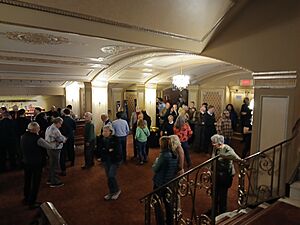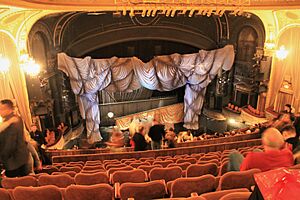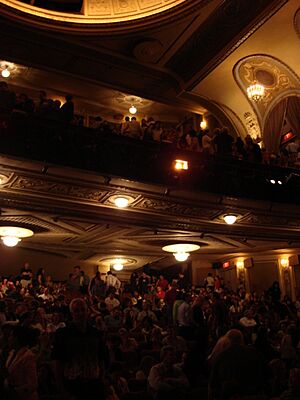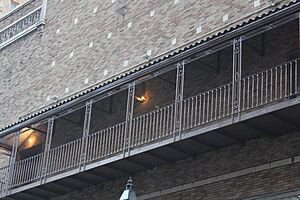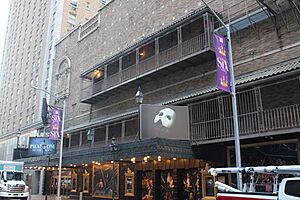Majestic Theatre (Broadway) facts for kids
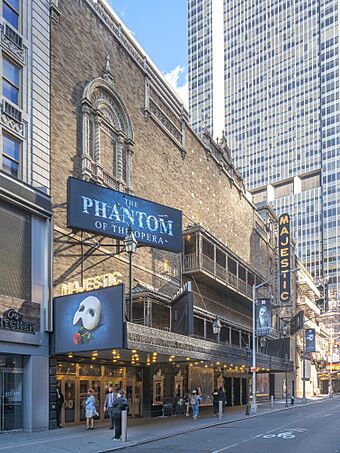 |
|
| Address | 245 West 44th Street Manhattan, New York United States |
|---|---|
| Coordinates | 40°45′30″N 73°59′17″W / 40.75833°N 73.98806°W |
| Public transit | Subway: Times Square–42nd Street/Port Authority Bus Terminal |
| Owner | Majestic Theatre LLC |
| Operator | The Shubert Organization |
| Type | Broadway |
| Capacity | 1,681 |
| Production | Gypsy |
| Construction | |
| Opened | March 28, 1927 |
| Years active | 1927–present |
| Architect | Herbert J. Krapp |
| Designated | December 8, 1987 |
| Reference no. | 1355 |
| Designated entity | Facade |
| Designated | December 8, 1987 |
| Reference no. | 1356 |
| Designated entity | Lobby and auditorium interior |
The Majestic Theatre is a famous Broadway theater in New York City. It is located at 245 West 44th Street in the Theater District of Midtown Manhattan. The theater first opened in 1927. It was designed by Herbert J. Krapp in a beautiful Spanish style.
The Majestic Theatre was built for a real estate developer named Irwin S. Chanin. It has 1,681 seats for audiences and is managed by The Shubert Organization. Both the outside (called the facade) and the inside of the theater are protected as New York City landmarks. This means they are important historical places.
The Majestic Theatre is known for hosting many big musical theater shows. Some famous musicals that first opened here include Carousel, South Pacific, The Music Man, and The Wiz. From 1988 to 2023, the theater was home to The Phantom of the Opera. This show became the longest-running production in Broadway history!
Contents
Where is the Majestic Theatre?
The Majestic Theatre is at 245 West 44th Street. It is on the north side of the street, between Eighth Avenue and Seventh Avenue. This area is very close to Times Square in the Theater District of Midtown Manhattan.
The theater is part of a block with many other Broadway theaters. It shares the block with the Row NYC Hotel and other theaters like the John Golden and Bernard B. Jacobs. This block has the largest number of Broadway theaters in one place.
How the Theatre Looks
The Majestic Theatre was designed by Herbert J. Krapp. It was built between 1926 and 1927. Krapp designed it in a Spanish style. The Majestic was part of a larger entertainment complex. This complex also included the Lincoln Hotel and two other theaters, the Masque (now Golden) and Royale (now Jacobs). All these buildings were designed in a similar Spanish style. The Majestic was planned to be the biggest theater in this group.
Outside Look (Facade)
The outside of the Majestic Theatre, called its facade, has two different parts. The wider part on the west side is where the audience enters. The narrower part on the east side is taller and holds the stage area.
The bottom floor of the theater is covered in rough-looking terracotta blocks. The upper floors are made of gold-colored bricks. The brick design was chosen to match the nearby theaters and hotel.
The main entrance has glass and aluminum doors. Above the entrance is a metal sign, called a marquee, that shows what production is playing. On the upper floors, there are two outdoor walkways. These walkways are used as fire exits. They have pretty wrought-iron railings and metal roofs that look like Spanish tiles.
Inside Look (Interior)
Krapp designed the inside of the Majestic in a fancy style, popular during the time of King Louis XV of France. The colors used are ivory (a creamy white) and gold.
The main lobby is where you enter the theater. It has three double doors that lead to a large entrance area. This area has decorated walls and a vaulted ceiling with wavy designs. There are also chandeliers hanging from the ceiling.
A stone staircase in the lobby leads up to the seating areas. This staircase has metal railings and decorated walls with flower designs. It goes up to a hallway that surrounds the main seating area.
Seating Areas
The main seating area, called the auditorium, has an orchestra level (the seats on the ground floor) and one balcony above it. There are also special box seats near the stage. The Majestic is one of the biggest Broadway theaters. It has 1,681 seats.
The orchestra level has seats that slope upwards, especially at the back. This is called stadium seating, and it helps everyone see the stage. The very back row of the orchestra is actually on a higher level, above the entrance.
The balcony also has front and back sections. Its side walls have arched panels with designs of leaves and flowers. Brass lights are on the walls, and chandeliers hang from the ceiling. The front of the balcony has decorative railings.
Stage and Other Features
Near the stage is a large archway called the proscenium arch. This arch frames the stage. It is decorated with rope and vine designs. For the musical The Phantom of the Opera, some changes were made to this arch. Holes were cut, and walkways were added above the stage.
Above the proscenium arch, the ceiling curves upwards. This area has a large oval design of the goddess Venus. The main ceiling has a dome shape, surrounded by twisted vines and square panels.
History of the Majestic Theatre
The area around Times Square became very important for big theater shows in the early 1900s. The Chanin brothers, who built the Majestic, were interested in creating new theaters. They wanted to make theaters that were beautiful and comfortable for everyone.
Early Years and Ownership Changes
The Chanin brothers bought the land for the Majestic Theatre in 1925. They planned to build a hotel and three theaters there. The Majestic Theatre officially opened on March 28, 1927. It was the last of the three theaters in their complex to open.
The Majestic was meant for large musical shows and revues. However, some early shows were not very successful. In 1929, the Shubert brothers bought half ownership of the Majestic and two other theaters from the Chanin brothers. The Shuberts have operated the Majestic ever since.
In the 1930s and early 1940s, the Majestic hosted many operettas and musicals. Some shows were very popular, while others closed quickly. Many long-running shows from other theaters also moved to the Majestic to finish their runs. For example, a successful revival of Porgy and Bess played here in 1942.
Later Shubert Operation
In 1945, the Shubert brothers gained full ownership of the Majestic Theatre. From the late 1940s to the 1960s, the Majestic became a favorite place for musicals by the famous team of Rodgers and Hammerstein. Their show Carousel opened here in 1945 and ran for a long time. Another huge hit was South Pacific, which ran for over 1,900 performances starting in 1949.
The 1950s brought more successful musicals, including The Music Man in 1957 and Camelot in 1960. Camelot starred famous actors like Julie Andrews and Richard Burton. In the mid-1960s, the theater hosted a benefit concert called Broadway Answers Selma to support the civil rights movement.
In the 1970s, the Majestic continued to host popular musicals like Sugar and A Little Night Music. A very successful show called The Wiz, an all-Black adaptation of The Wonderful Wizard of Oz, opened here in 1975.
In 1987, the outside and inside of the Majestic Theatre were officially named New York City landmarks. This helps protect the theater's unique design and history.
The Phantom of the Opera Era
In March 1987, it was announced that the famous musical The Phantom of the Opera would open at the Majestic. The theater underwent over $1 million in changes to fit the show's amazing set. For example, the opening around the stage was made bigger, and the roof was strengthened to hold the show's famous falling chandelier.
Phantom officially opened on January 26, 1988. It was a huge success, just like its London production. It played continuously at the Majestic for many years. In 2006, Phantom became the longest-running show in Broadway history. By 2012, it had been performed over 10,000 times!
The theater closed on March 12, 2020, because of the COVID-19 pandemic. It reopened on October 22, 2021, with Phantom continuing its run. However, the show struggled to attract enough audience members after the pandemic. In September 2022, the producers announced that Phantom would close. Its final performance was on April 16, 2023, after an incredible 13,981 shows.
Recent Productions
After Phantom closed, the large sign outside the Majestic was repainted to its original red color. In late 2024, the musical Gypsy, starring Audra McDonald, began performances at the Majestic. It officially opened on December 19, 2024. The production of Gypsy closed in August 2025.
Notable Productions
Here are some of the important shows that have played at the Majestic Theatre:
| Opening year | Name |
|---|---|
| 1927 | Rang Tang |
| 1928 | Rio Rita |
| 1930 | Artists and Models |
| 1931 | The Student Prince |
| 1933 | Pardon My English |
| 1934, 1936 | Gilbert and Sullivan Series |
| 1937 | Babes in Arms |
| 1941 | Hellzapoppin |
| 1942 | Porgy and Bess |
| 1943 | Junior Miss |
| 1945, 1949 | Carousel |
| 1947 | Allegro |
| 1949 | South Pacific |
| 1954 | Fanny |
| 1957 | The Music Man |
| 1960 | Camelot |
| 1964 | Golden Boy |
| 1967 | Fiddler on the Roof |
| 1971 | 1776 |
| 1972 | Sugar |
| 1973 | A Little Night Music |
| 1975 | The Wiz |
| 1977 | The Act |
| 1979 | Bette! Divine Madness |
| 1981 | 42nd Street |
| 1988 | The Phantom of the Opera |
| 2024 | Gypsy |
See also
- List of Broadway theatres
- List of New York City Designated Landmarks in Manhattan from 14th to 59th Streets





